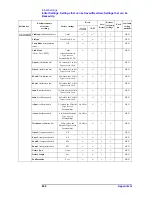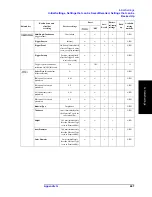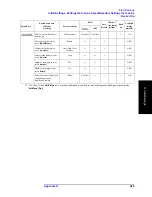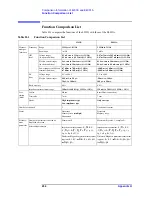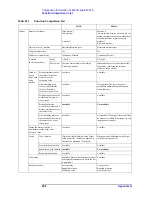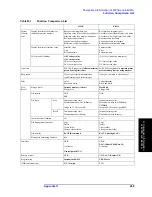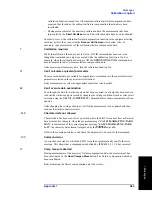
452
Appendix H
Comparison Information of 4291B and E4991A
Major Differences
Major Differences
Channels and Traces
Changes in concept
The 4291B has two channels. Both channels can sweep together or separately under two
independent conditions (for example, frequency sweep and OCS level sweep). Impedance
measurement results of each channel are converted into the selected parameter and then
displayed.
On the other hand, the closest thing to a channel concept in the E4991A is its having five
traces (3 scalar and 2 complex). The difference between channel and trace is that
conditions, including the sweep condition, can be set independently in the channel concept,
while all such conditions are common to all traces in the trace concept.
Changes in functions
•
The 4291B can simultaneously display a maximum of two kinds of parameters, but the
E4991A can simultaneously display a maximum of five kinds of parameters (3 scalar, 2
complex).
•
The 4291B can sweep based on two kinds of sweep parameters (for example,
frequency sweep and OSC level sweep), but the E4991A cannot do this.
Calibration/Compensation
Changes in concept
In the 4291B, the calibration/compensation procedure (calibrate on the designated
calibration plane and compensate error elements of the test fixture) was complicated for
some users, so they used the instrument without appropriate calibration/compensation. In
the E4991A, the calibration/compensation procedure is simplified to prevent such
difficulties. In the normal procedure, Open/Short/Load compensation is executed after
executing Open/Short/Load/Low loss capacitor calibration. In the E4991A, error
compensation can be done by executing Open/Short/Load calibration on the test fixture
material contact plane.
Changes in functions
•
The 4291B has LOAD compensation, but the E4991A doesn’t because of the concept
described above.
•
Just one reference value of the LOAD calibration is set to cover the entire frequency
range in the 4291B, but separate reference values of LOAD calibration can be set for
each frequency point in the E4991A (this setting can be made by just issuing a GPIB
command).
•
The 4291B has two modes: USER mode (both frequency and OSC level are set by the
user) and FIXED POINT mode (both frequency and OSC level are fixed). On the other
hand, the E4991A has an additional user setting mode in which frequency is fixed and
OSC level is set by users.
NOTE
For details on the E4991A’s calibration/compensation functions, see Chapter 4,
Summary of Contents for E4991A
Page 6: ......
Page 24: ...18 Contents ...
Page 80: ...74 Chapter3 Setting Measurement Conditions Averaging Measurement Results ...
Page 220: ...214 Chapter9 Setup and Use of Control Management Functions System Recovery ...
Page 338: ...332 AppendixB Probe Station Connection Kit Option 010 OPEN SHORT LOAD Calibration ...
Page 428: ...422 AppendixD Menu References Menu References ...
Page 482: ...476 AppendixI Messages Wait measuring comp standard ...









